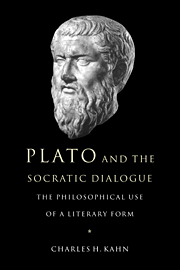Book contents
- Frontmatter
- Contents
- Preface
- List of abbreviations
- 1 Sōkratikoi logoi: the literary and intellectual background of Plato's work
- 2 The interpretation of Plato
- 3 Socrates
- 4 Plato as a minor Socratic: Ion and Hippias Minor
- 5 Gorgias: Plato's manifesto for philosophy
- 6 The priority of definition: from Laches to Meno
- 7 Charmides and the search for beneficial knowledge
- 8 Protagoras: virtue as knowledge
- 9 The object of love
- 10 The emergence of dialectic
- 11 The presentation of the Forms
- 12 Phaedrus and the limits of writing
- Appendix On Xenophon's use of Platonic texts
- Bibliography
- Indexes
11 - The presentation of the Forms
Published online by Cambridge University Press: 02 November 2009
- Frontmatter
- Contents
- Preface
- List of abbreviations
- 1 Sōkratikoi logoi: the literary and intellectual background of Plato's work
- 2 The interpretation of Plato
- 3 Socrates
- 4 Plato as a minor Socratic: Ion and Hippias Minor
- 5 Gorgias: Plato's manifesto for philosophy
- 6 The priority of definition: from Laches to Meno
- 7 Charmides and the search for beneficial knowledge
- 8 Protagoras: virtue as knowledge
- 9 The object of love
- 10 The emergence of dialectic
- 11 The presentation of the Forms
- 12 Phaedrus and the limits of writing
- Appendix On Xenophon's use of Platonic texts
- Bibliography
- Indexes
Summary
WHAT IS PLATO'S THEORY OF FORMS?
It would be difficult to overstate the importance of the concept of Forms in Plato's work. As the distinctive object of philosophical knowledge, the Forms in the Republic provide the criterion for distinguishing philosophers from non-philosophers. The Forms play this central role in Plato's epistemology precisely because they constitute the basic entities in his ontology. Furthermore, as source of value and ultimate object of desire, the Forms are equally fundamental in Plato's moral psychology, as we have seen in Chapter 9. In ethics and political theory they provide a paradeigma, a pattern to be imitated in the moral life as well as in the construction and government of the best city. In theology also the Forms are paradigmatic, since it is by their relationship to the Forms that the gods themselves are divine (Phaedrus 249c). In the Cratylus and the Sophist the Forms provide the basis for a theory of language; in the Timaeus they constitute the framework for Plato's cosmology and philosophy of nature. In the Symposium and Phaedrus the Form of Beauty functions as a principle for esthetics and above all for an account of love, including an account of that privileged form of erōs that constitutes the life in philosophy. No doctrine in the history of philosophy has been more ambitious, and few have been so influential.
Nevertheless, the status of this doctrine in Plato's work is problematic in more than one respect.
- Type
- Chapter
- Information
- Plato and the Socratic DialogueThe Philosophical Use of a Literary Form, pp. 329 - 370Publisher: Cambridge University PressPrint publication year: 1997



